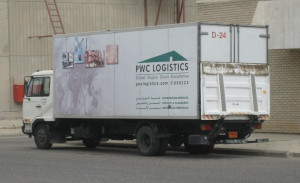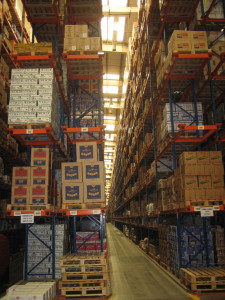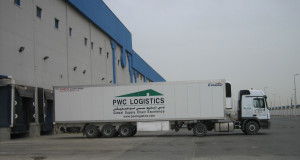PWC Logistics Joins the Top 25 Global 3PLs
Kuwait
May 2-3, 2006
By
Evan Armstrong
Key Personnel:
Tarek Sultan, Chairman & Managing Director
Essa Al-Saleh, Managing Director – Corporate Development
Emad Al-Saleh, Business Development Director
Toufic Kortbawi, Director of Operations – Kuwait
Rick Anchan, Director – Business Integration
Steven Nelson, Asst. General Manager of PV Operations
Girish Chandra Dube, Senior IT Manager
Anders Bjerregaard, Manager of Transport Solutions Development
Faisal Al-Hamad, Business Development Manager
Ghassan Assaad, DLA-DDKS Alternative Site Manger
Vision and Growth
In 1997 PWC Logistics began providing logistics services and with 2005 revenues of $3 billion it made a rapid ascent to its current position as the 15th largest global third-party logistics provider. When you speak with PWC’s straight-forward Chairman & Managing Director Tarek Sultan, you understand how this growth has been accomplished. Sultan has developed an entrepreneurial organization that is focused on customer service and facilitating global trade.
In 2005, PWC made three acquisitions including Santa Ana, CA based global freight forwarder GeoLogistics Corporation. GeoLogistics added extensive international transportation management capabilities to PWC’s previously middle-eastern centric operations. “We will always look for acquisition opportunities that make sense in addressing the service needs of our target markets and customers”, said Sultan. For new business, PWC targets customers trading with the middle-east, those with tradeshow/exhibition and project cargo logistics requirements, and customers with businesses in the high-tech, government & military, and oil & gas industry verticals.
 While most logistics providers focus discussions on non-asset based business models, PWC takes an openly different approach. According to Sultan, “We use assets in markets where they are necessary. Instead of focusing on an asset versus non-asset business model, we focus on what we like to call an asset appropriate model. Where we need to, we will acquire assets to meet our customers’ needs.” For example, because of the U.S. Military’s extensive supply needs for its bases in Iraq, PWC responded by expanding its warehousing and trucking operations with the necessary capacity and service capabilities needed to support the U.S. led operations. Every day, PWC runs approximately 150 truckloads of supplies into Iraq.
While most logistics providers focus discussions on non-asset based business models, PWC takes an openly different approach. According to Sultan, “We use assets in markets where they are necessary. Instead of focusing on an asset versus non-asset business model, we focus on what we like to call an asset appropriate model. Where we need to, we will acquire assets to meet our customers’ needs.” For example, because of the U.S. Military’s extensive supply needs for its bases in Iraq, PWC responded by expanding its warehousing and trucking operations with the necessary capacity and service capabilities needed to support the U.S. led operations. Every day, PWC runs approximately 150 truckloads of supplies into Iraq.
Essa Al-Saleh, Managing Director – Corporate Development is responsible for identifying potential growth opportunities for PWC. “We have developed an eight-by-eight strategy”, said Al-Saleh. He explained that PWC wants to meet the following goals by 2008:
- Be a top 8 global logistics provider
- Have all PWC operations fully integrated (“Integr8”)
- Obtain $8 billion in gross revenues
- Realize $8 hundred million in net profit
- Be the market leader in the top 8 middle east economies
- Have 8 globally integrated supply chain customers
- Lead in 8 key operating metrics
According to Al-Saleh, PWC has a goal of managing value-added warehousing operations within each major middle-eastern city supported by PWC’s trucking network. He emphasized that PWC is not risk adverse and is willing to make substantial commitments in countries such as Iraq that are currently avoided by other providers. Al-Saleh said that PWC is currently looking at opening four warehouses in Saudi Arabia and sees growth opportunities in the European Union, especially in providing distribution services in Germany and the Czech Republic.
To help integrate the new and existing operations, PWC recruited Menlo and UTi veteran Rick Anchan. Anchan is currently heading a business process reengineering effort and is helping to rationalize and develop the new post-acquisition organizational structure.
Kuwaiti Distribution Operations
Toufic Kortbawi manages PWC’s Kuwaiti operations and provided us with a detailed tour. Most of the finished goods consumed in Kuwait are imported by PWC’s customers; therefore the main emphasis of PWC’s current Kuwaiti operations is on outbound distribution. PWC utilizes SSA Global’s (being acquired by Infor) EXE–Exceed warehouse management system (WMS) and proprietary transportation management and customs clearance systems to efficiently coordinate operations. Integrated radio frequency devices (RF) are used for picking and putaway. An internet portal provides customers with inventory and order visibility. Operations are staffed by full-time employees who are paid very well by local standards.
PWC’s supply chain management services include: customs clearance, domestic and international multi-modal transportation management, value-added warehousing, reverse logistics, project cargo, bonded storage, liquid and dry bulk commodities handling, cross docking, temperature controlled handling, hazardous materials handling, and inventory management. PWC’s Kuwait operations are ISO 9001:2000 certified.
 20K
20K
The first distribution center we visited was dubbed “20K” because it has 20,000 square meters (215,280 square feet) of space. The 20K operation is a very modern 6 1/2 year old narrow aisle food-grade facility serving approximately 100 customers. Major customers include: Sony and Henkel. 80% of the product warehoused in 20K is food and grocery related.
Prime Vendor – “PV”
The second warehouse we toured was PWC’s 18,000 square meter (193,752 square feet) 2 1/2 year old “Prime Vendor” (PV) warehouse next door to 20K. PWC Logistics is contracted by the DSCP (Defense Supply Center Philadelphia) to store and distribute food and non-food products to the US Army, Navy, Marines, and Air Force operating in the regions of Kuwait, Qatar, and Iraq.
When you enter the PV warehouse you realize that you are not touring a typical logistics operation. Displayed on the left-hand wall are plaques honoring PWC employees that have died in attacks enroute to and from bases in Iraq. Having to deal with this level of risk gives new meaning to providing exceptional customer service.
 The PV operation processes 30 to 40 large orders per day filling approximately 3 to 4 outbound truckloads. Orders are received electronically from the DSCP in Philadelphia into the EXE WMS for fulfillment. PWC owns the warehoused product until it is received by the U.S. Military. PV operates dry, refrigerated and frozen space for products including two -21º Celsius (-6º Fahrenheit) freezers.
The PV operation processes 30 to 40 large orders per day filling approximately 3 to 4 outbound truckloads. Orders are received electronically from the DSCP in Philadelphia into the EXE WMS for fulfillment. PWC owns the warehoused product until it is received by the U.S. Military. PV operates dry, refrigerated and frozen space for products including two -21º Celsius (-6º Fahrenheit) freezers.
Mina Abdullah Defense Logistics Agency (DLA) Facilities
The Mina Abdullah DLA-DDKS (Defense Depot Kuwait, Southwest Asia) operation is a six warehouse campus with approximately one million square feet of space serving the U.S. Military’s global operations. Literally developed out of the desert, PWC developed and brought the entire DLA operation online in four months. It has been running since August of 2004. The Kuwait DDKS replaced a similar operation in Bahrain for an estimated transportation cost savings of $160 million to the U.S. Military.
Approximately 2,000 orders are received for fulfillment each day. Orders consist of non-food military supplies: parts, uniforms, bulk supplies, etc. PWC averages less than ten hours to fill and ship orders from time of order receipt.
Of the six warehouses, we were able to tour three. Warehouse number four (WH4) is 18,000 square meters (193,752 square feet) and contains approximately 23,000 stock keeping units (SKUs). 52 workers man the warehouse on three shifts. Approximately 50 to 60 inbound containers supply WH4 each day and approximately 60% of the total DDKS orders are filled from WH4. The warehouse has approximately 6,000 pallet locations and 38,000 bin locations. Most of the product in WH4 is replacement parts including screws, nuts, and bolts. The operation requires extensive piece picking. PWC is currently running at 99.7% inventory accuracy and the inventory turns approximately six to seven times per year.
Warehouse number five (WH5) operates as an outbound and inbound cross dock. Air pallets of product are built by PWC and loaded on flat bed trailers for transport to U.S. Air Force air cargo planes for final delivery to military bases. Each air pallet has an active RFID tag containing order and item information. Approximately 25 to 30 outbound truckloads of product are shipped from WH5 each day.
Warehouse number one (WH1) is approximately 157,000 square feet and is used to store hazardous materials. WH1 employees a staff of 22 workers over three shifts. Approximately 514 SKUs are kept on-hand including: lubricants, corrosives, petrochemicals, and some minor radioactive products. The facility is well equipped with containment barriers, spill kits, hazmat suits, and eyewash stations. To date PWC has maintained 100% inventory accuracy in WH1.
Emphasis on Technology
In addition to its tier-one EXE WMS, PWC Logistics has developed two proprietary systems to facilitate transportation management and international trade: MicroTransport and MicroClear.
MicroTransport
Built upon Microsoft’s .Net framework, MicroTransport is a proprietary transportation management system (TMS) developed by PWC to provide customers with order/shipment visibility through an internet portal. MicroTransport is fully integrated with the EXE WMS and GPS units on each truck for real-time order/shipment visibility across the supply chain. Main functionality includes:
- Customer order tracking
- RFID compatibility
- Vehicle tracking
- Vehicle manifest details visibility
- Vehicle aging by location
- In-transit visibility
- Vehicle status management
- Convoy status management
- Digital vehicle location mapping
Along with complete order/shipment visibility, MicroTransport also provides for dynamic and static routing, yard management, and has extensive reporting capabilities.
MicroClear
Except for performing customs inspections, PWC manages all customs clearance operations for the Kuwaiti government. Key to supporting the operation is its proprietary MicroClear customs management system. MicroClear has functions for full: cargo processing, customs declarations, risk management, cargo inspections, post clearance audits, case management, and revenue collection. It also fully supports the WCO’s harmonized commodity and coding system. The MicroClear system is currently being considered for use by two other countries.
In summary, with solid systems, a risk-taking entrepreneurial spirit, and a targeted approach to growth, PWC is on track to meet its eight-by-eight goals.


